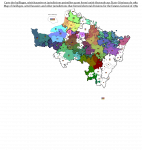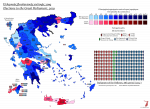Well, the 1789 elections may be a headache to map, but the succeeding ones - held in 1791 - are very, very easy. You see, the National Constituent Assembly had been fairly quick to decide that yeah, these administrative divisions are just utterly unsalvageable, aren't they, we should probably put something new in. After the famous brief flirtation with square administrative divisions, they decided to instead adopt a division into 83 departments, very loosely based on the old provinces or divisions thereof, which would be roughly equal in surface area. These would serve as primary local administrative units, court districts, and among many, many subsidiary functions, also electoral divisions for the new Legislative Assembly provided for in the Constitution of 1791.
The Assembly would be unicameral, which was a fairly radical notion for its time, and its size was fixed at 745. Three seats were fixed to each department, which made up about a third of the total (247). Of the rest, 249 were assigned according to number of active citizens (taxpaying men above 25), and 249 according to the amount of tax paid in the department. While this meant the distribution didn't match population, we can see how much more rural France was at the time - the only cities large enough to skew their departments were Paris (which was of course its own department along with its suburbs - this department would be renamed the Seine in 1795) and Lyon.
If the administrative division and the working structure of the Assembly were radical for their time, the electoral system was very much not. I mention "active citizens" - well, one of the main things distinguishing them from "passive citizens" was that they got to vote. And they only elected delegates to a departmental primary assembly, who
in turn elected the department's delegates. This was seen as a prudent move by the sort of liberal reformers who ran the Constituent, whose main goals were to ensure good government and prevent mob rule, but the sans-culottes of Paris and the poor peasants of the countryside saw it as a betrayal of the Revolution's ideals. As the months wore on, the Legislative Assembly failed to win much support from anyone, and after provoking a great power war for fun and profit, it would fall like a house of cards in the fateful days of August 1792.
View attachment 11851






